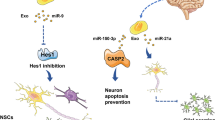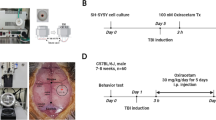Abstract
Edaravone is a novel free radical scavenger that is clinically employed in patients with acute cerebral infarction, but has not previously been used to treat traumatic brain injury (TBI). In this study, we investigated the effect of edaravone administration on rat TBI. In particular, we used immunohistochemistry to monitor neural stem cell (NSC) proliferation around the area damaged by TBI. Two separate groups of rats were administered saline or edaravone (3 mg/kg) after TBI and then killed chronologically. We also used ex vivo techniques to isolate NSCs from the damaged region and observed nestin-positive cells at 1, 3, and 7 days following TBI in both saline- and edaravone-treated groups. At 3 days following TBI in both groups, there were many large cells that morphologically resembled astrocytes. At 1 and 7 days following TBI in the saline group, there were a few small nestin-positive cells. However, in the edaravone group, there were many large nestin-positive cells at 7 days following TBI. At 3 and 7 days following TBI, the number of nestin-positive cells in the edaravone group increased significantly compared with the saline group. There were many single-stranded DNA-, 8-hydroxy-2′-deoxyguanosine-, and 4-hydroxy-2-nonenal-positive cells in the saline group following TBI, but only a few such cells in the edaravone group following TBI. Furthermore, almost all ssDNA-positive cells in the saline group co-localized with Hu, nestin, and glial fibrillary acidic protein (GFAP) staining, but not in the edaravone group. In the ex vivo study, spheres could only be isolated from injured brain tissue in the saline group at 3 days following TBI. However, in the edaravone group, spheres could be isolated from injured brain tissue at both 3 and 7 days following TBI. The number of spheres isolated from injured brain tissue in the edaravone group showed a significant increase compared with the saline group. The spheres isolated from both saline and edaravone groups were immunopositive for nestin, but not Tuj1 or vimentin. Moreover, the spheres differentiated into Tuj1-, GFAP-, and O4-positive cells after 4 days in culture without bFGF. This result indicated that the spheres were neurospheres composed of NSCs that could differentiate into neurons and glia. Edaravone administration inhibited production of free radicals known to induce neuronal degeneration and cell death after brain injury, and protected nestin-positive cells, including NSCs, with the potential to differentiate into neurons and glia around the area damaged by TBI.








Similar content being viewed by others
References
Arai T, Nonogawa M, Makino K, Endo N, Mori H, Miyoshi T, Yamashita K, Sasada M, Kakuyama M, Fukuda K (2008) The radical scavenger edaravone (3-methyl-1-phenyl-2-pyrazolin-5-one) reacts with a pterin derivative and produces a cytotoxic substance that induces intracellular reactive oxygen species generation and cell death. J Pharmacol Exp Ther 324:529–538
Ates O, Cayli S, Altinoz E, Gurses I, Yucel N, Sener M, Kocak A, Yologlu S (2007) Neuroprotection by resveratrol against traumatic brain injury in rats. Mol Cell Biochem 294:137–144
Azbill RD, Mu X, Bruce-Keller AJ, Mattson MP, Springer JE (1997) Impaired mitochondrial function, oxidative stress and altered antioxidant enzyme activities following traumatic spinal cord injury. Brain Res 765:283–290
Chen S, Pickard JD, Harris NG (2003) Time course of cellular pathology after controlled cortical impact injury. Exp Neurol 182:87–102
Chirumamilla S, Sun D, Bullock MR, Colello RJ (2002) Traumatic brain injury induced cell proliferation in the adult mammalian central nervous system. J Neurotrauma 19:693–703
Clausen F, Lundqvist H, Ekmark S, Lewen A, Ebendal T, Hillered L (2004) Oxygen free radical-dependent activation of extracellular signal-regulated kinase mediates apoptosis-like cell death after traumatic brain injury. J Neurotrauma 21:1168–1182
Dohi K, Satoh K, Mihara Y, Nakamura S, Miyake Y, Ohtaki H, Nakamachi T, Yoshikawa T, Shioda S, Aruga T (2006) Alkoxyl radical-scavenging activity of edaravone in patients with traumatic brain injury. J Neurotrauma 23:1591–1599
Douen AG, Dong L, Vanance S, Munger R, Hogan MJ, Thompson CS, Hakim AM (2004) Regulation of nestin expression after cortical ablation in adult rat brain. Brain Res 1008:139–146
Hall ED, Braughler JM (1989) Central nervous system trauma and stroke. II. Physiological and pharmacological evidence for involvement of oxygen radicals and lipid peroxidation. Free Radic Biol Med 6:303–313
Irving EA, Bamford M (2002) Role of mitogen- and stress-activated kinases in ischemic injury. J Cereb Blood Flow Metab 22:631–647
Ishii J, Natsume A, Wakabayashi T, Takeuchi H, Hasegawa H, Kim SU, Yoshida J (2007) The free-radical scavenger edaravone restores the differentiation of human neural precursor cells after radiation-induced oxidative stress. Neurosci Lett 423:225–230
Itoh T, Satou T, Hashimoto S, Ito H (2005) Isolation of neural stem cells from damaged rat cerebral cortex after TBI. NeuroReport 16:1687–1691
Itoh T, Satou T, Nishida S, Hashimoto S, Ito H (2006) Cultured rat astrocytes give rise to neural stem cells. Neurochem Res 31:1381–1387
Itoh T, Satou T, Hashimoto S, Ito H (2007) Immature and mature neurons coexist among glial scars after rat traumatic brain injury. Neurol Res 29:734–742
Itoh T, Satou T, Nishida S, Tsubaki M, Hashimoto S, Ito H (2009) Improvement of cerebral function by anti-amyloid precursor protein antibody infusion after traumatic brain injury in rats. Mol Cell Biochem 324:191–199
Kawamata T, Katayama Y, Hovda DA, Yoshino A, Becker DP (1995) Lactate accumulation following concussive brain injury: the role of ionic fluxes induced by excitatory amino acids. Brain Res 674:196–204
Kontos HA (1985) George E. Brown memorial lecture. Oxygen radicals in cerebral vascular injury. Circ Res 57:508–516
Kuhn HG, Dickinson-Anson H, Gage FH (1996) Neurogenesis in the dentate gyrus of the adult rat: age-related decrease of neuronal progenitor proliferation. J Neurosci 16:2027–2033
Lin HJ, Wang X, Shaffer KM, Sasaki CY, Ma W (2004) Characterization of H2O2-induced acute apoptosis in cultured neural stem/progenitor cells. FEBS Lett 570:102–106
Lois C, Alvarez-Buylla A (1994) Long-distance neuronal migration in the adult mammalian brain. Science 264:1145–1148
Mizuno A, Umemura K, Nakashima M (1998) Inhibitory effect of MCI-186, a free radical scavenger, on cerebral ischemia following rat middle cerebral artery occlusion. Gen Pharmacol 30:575–578
Moon C, Ahn M, Kim S, Jin JK, Sim KB, Kim HM, Lee MY, Shin T (2004) Temporal patterns of the embryonic intermediate filaments nestin and vimentin expression in the cerebral cortex of adult rats after cryoinjury. Brain Res 1028:238–242
Nishi H, Watanabe T, Sakurai H, Yuki S, Ishibashi A (1989) Effect of MCI-186 on brain edema in rats. Stroke 20:1236–1240
Niyaz M, Numakawa T, Matsuki Y, Kumamaru E, Adachi N, Kitazawa H, Kunugi H, Kudo M (2007) MCI-186 prevents brain tissue from neuronal damage in cerebral infarction through the activation of intracellular signaling. J Neurosci Res 85:2933–2942
Parent JM, Yu TW, Leibowitz RT, Geschwind DH, Sloviter RS, Lowenstein DH (1997) Dentate granule cell neurogenesis is increased by seizures and contributes to aberrant network reorganization in the adult rat hippocampus. J Neurosci 17:3727–3738
Picard-Riera N, Nait-Oumesmar B, Baron-Van EA (2004) Endogenous adult neural stem cells: limits and potential to repair the injured central nervous system. J Neurosci Res 76:223–231
Rice AC, Khaldi A, Harvey HB, Salman NJ, White F, Fillmore H, Bullock MR (2003) Proliferation and neuronal differentiation of mitotically active cells following traumatic brain injury. Exp Neurol 183:406–417
Seri B, Garcia-Verdugo JM, McEwen BS, Alvarez-Buylla A (2001) Astrocytes give rise to new neurons in the adult mammalian hippocampus. J Neurosci 21:7153–7160
Sugawara T, Noshita N, Lewen A, Gasche Y, Ferrand-Drake M, Fujimura M, Morita-Fujimura Y, Chan PH (2002) Overexpression of copper/zinc superoxide dismutase in transgenic rats protects vulnerable neurons against ischemic damage by blocking the mitochondrial pathway of caspase activation. J Neurosci 22:209–217
Tsuji M, Inanami O, Kuwabara M (2000) Neuroprotective effect of alpha-phenyl-N-tert-butylnitrone in gerbil hippocampus is mediated by the mitogen-activated protein kinase pathway and heat shock proteins. Neurosci Lett 282:41–44
Walton KM, DiRocco R, Bartlett BA, Koury E, Marcy VR, Jarvis B, Schaefer EM, Bhat RV (1998) Activation of p38MAPK in microglia after ischemia. J Neurochem 70:1764–1767
Watanabe T, Yuki S, Egawa M, Nishi H (1994) Protective effects of MCI-186 on cerebral ischemia: possible involvement of free radical scavenging and antioxidant actions. J Pharmacol Exp Ther 268:1597–1604
Wen J, Watanabe K, Ma M, Yamaguchi K, Tachikawa H, Kodama M, Aizawa Y (2006) Edaravone inhibits JNK-c-Jun pathway and restores anti-oxidative defense after ischemia-reperfusion injury in aged rats. Biol Pharm Bull 29:713–718
Wu T, Ding XS, Wang W, Wu J (2006) MCI-186 (3-methyl-1-phenyl-2-pyrazolin-5-one) attenuated simulated ischemia/reperfusion injury in cultured rat hippocampal cells. Biol Pharm Bull 29:1613–1617
Xiong Y, Gu Q, Peterson PL, Muizelaar JP, Lee CP (1997) Mitochondrial dysfunction and calcium perturbation induced by traumatic brain injury. J Neurotrauma 14:23–34
Yamamoto T, Yuki S, Watanabe T, Mitsuka M, Saito KI, Kogure K (1997) Delayed neuronal death prevented by inhibition of increased hydroxyl radical formation in a transient cerebral ischemia. Brain Res 762:240–242
Yamamoto S, Nagao M, Sugimori M, Kosako H, Nakatomi H, Yamamoto N, Takebayashi H, Nabeshima Y, Kitamura T, Weinmaster G, Nakamura K, Nakafuku M (2001) Transcription factor expression and Notch-dependent regulation of neural progenitors in the adult rat spinal cord. J Neurosci 21:9814–9823
Yasuoka N, Nakajima W, Ishida A, Takada G (2004) Neuroprotection of edaravone on hypoxic-ischemic brain injury in neonatal rats. Brain Res Dev Brain Res 151:129–139
Acknowledgments
The authors thank Mari Machino for technical assistance.
Author information
Authors and Affiliations
Corresponding author
Rights and permissions
About this article
Cite this article
Itoh, T., Satou, T., Nishida, S. et al. The Novel Free Radical Scavenger, Edaravone, Increases Neural Stem Cell Number Around the Area of Damage Following Rat Traumatic Brain Injury. Neurotox Res 16, 378–389 (2009). https://doi.org/10.1007/s12640-009-9081-6
Received:
Revised:
Accepted:
Published:
Issue Date:
DOI: https://doi.org/10.1007/s12640-009-9081-6




